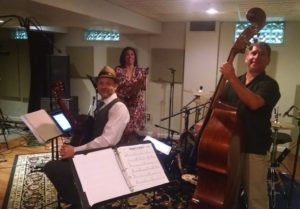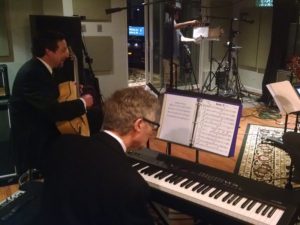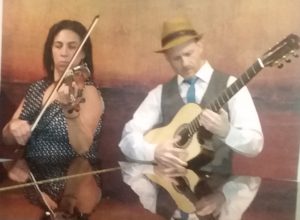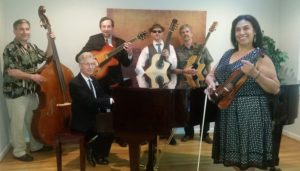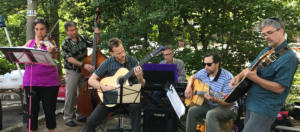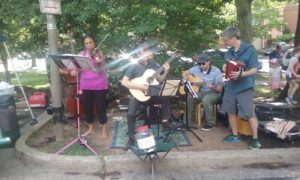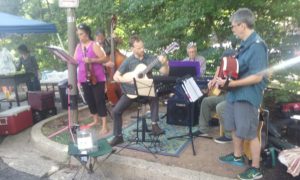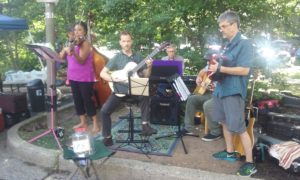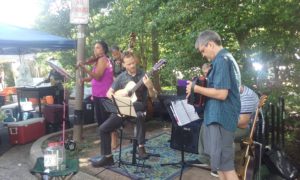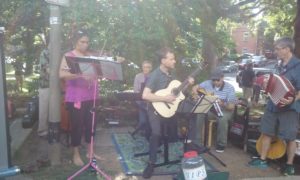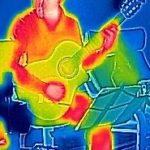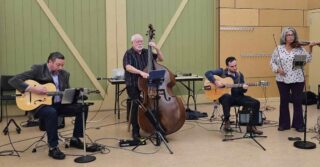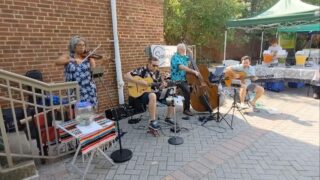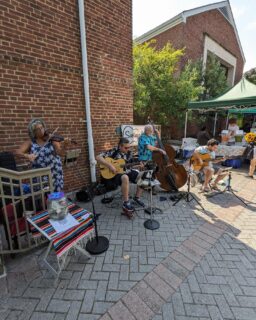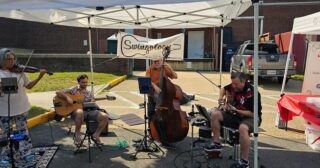Swingology – DC-based Band
Swingology at Canal Park on 10/16/24
Event Information
Swingology at Arlington Acoustic Cafe on 10/15/24
Event Information
Swingology at Arlington Acoustic Cafe on 10/13/24
Swingology at Fairlington Farmers Market on 10/13/24
Event Information
Swingology at Lubber Run Farmer’s Market on 10/12/24
Swingology at Westover Farmers Market on 10/06/24
Event Information
Swingology at Cherrydale Farmers Market on 10/05/24
Swingology at Waraku Japanese Restaurant on 06/16/24
Event Information
Swingology at Waraku Japanese Restaurant on 07/21/24
Event Information
Swingology at Canal Psrk on 05/08/24
Event Information
Swingology at Waraku Japanese Restaurant on 05/19/24
Event Information
Swingology at Private Party on 04/11/24
Event Information
Swingology at Waraku Japanese Restaurant on 04/14/24
Event Information
Swingology at Mt Vernon Farmers Market on 04/13/24
Event Information
Swingology at Alexandria, VA on 06/22/24
Event Information
Swingology at H Street NE Fresh Farm Farmers Market on 05/04/24
Event Information
Swingology at Fairlington Farmers Market on 11/03/24
Event Information
Swingology at Fairlington Farmers Market on 10/13/24
Swingology at Fairlington Farmers Market on 09/15/24
Event Information
Swingology at Fairlington Farmers Market on 08/11/24
Event Information
Swingology at Fairlington Farmers Market on 07/21/24
Swingology at Fairlington Farmers Market on 06/09/24
Event Information
Swingology at Fairlington Farmers Market on 06/23/24
Event Information
Swingology at Westover Farmers Market on 10/06/24
Swingology at Westover Farmers Market on 08/04/24
Event Information
Swingology at Cherrydale Farmers Market on 10/05/24
Event Information
Swingology at Lubber Run Farmer’s Market on 11/02/24
Event Information
Swingology at Lubber Run Farmer’s Market on 10/12/24
Event Information
Swingology at Lubber Run Farmer’s Market on 09/14/24
Event Information
Swingology at Vienna Farmers’ Market on 08/24/24
Event Information
Swingology at Lubber Run Farmer’s Market on 08/10/24
Event Information
Swingology at Vienna Farmers’ Market on 07/20/24
Event Information
Swingology at Lubber Run Farmer’s Market on 06/22/24
Event Information
Swingology at Cherrydale Farmers Market on 06/08/24
Event Information
Swingology at Westover Farmers Market on 06/02/24
Event Information
Swingology at Lubber Run Farmer’s Market on 05/18/24
Event Information
Swingology at Vienna Farmers’ Market on 05/11/24
Event Information
Swingology at American Legion Post 24 on 02/24/24
Event Information
Swingology at Waraku Japanese Restaurant on 02/25/23
Event Information
Swingology at Waraku Japanese Restaurant on 01/14/23
Event Information
Swingology at Waraku Japanese Restaurant on 12/10/23
Event Information
Swingology at DC Holiday Market on 12/20/23
Event Information
Swingology at Lost Boy Cidery on 12/18/23
Event Information
Swingology at Columbia Heights Farmers’ Market on 11/04/23
Event Information
Swingology at Bonita Lestina Concert Series on 11/03/23
Event Information
Swingology at H Street NE Fresh Farm Farmers Market on 10/04/23
Event Information
Swingology at Rosslyn Fresh Farm Farmers Market on 10/04/23
Event Information
Swingology at Private Party on 09/28/23
Event Information
Swingology at Private Party on 08/26/23
Event Information
Swingology at Fairlington Farmers Market on 10/15/23
Event Information
Swingology at Fairlington Farmers Market on 09/10/23
Event Information
Swingology at Fairlington Farmers Market on 08/06/23
Event Information
Swingology at Fairlington Farmers Market on 06/25/23
Event Information
Swingology at Columbia Heights Farmers’ Market on 08/05/23
Event Information
Swingology at Westover Farmers Market on 07/23/23
Event Information
Swingology at Ballston Farmers Marmet on 07/20/23
Event Information
Swingology at Columbia Pike Farmers Market on 06/11/23
Event Information
Swingology at Foggy Bottom Farmers Market on 06/07/23
Event Information
Swingology at Foggy Bottom Farmers Market on 06/07/23
Swingology at Reston Farmers Market on 05/03/23
Event Information
Swingology at Lake Accotink Park on 08/11/23
Event Information
Swingology at Private Party on 09/30/23
Event Information
Swingology at Vienna Farmers’ Market on 09/23/23
Event Information
Swingology at Vienna Farmers’ Market on 06/17/23
Event Information
Swingology at Cherrydale Farmers Market on 06/10/23
Event Information
Swingology at Vienna Farmers’ Market on 05/13/23
Event Information
Swingology at Westover Farmers Market on 05/07/23
Event Information
Swingology at West End Library on 04/30/23
Swingology at West End Library on 03/12/23
Event Information
Swingology at Columbia Heights Farmers’ Market on 11/19/22
Event Information
Swingology at Columbia Heights Farmers’ Market on 11/12/22
Event Information
Swingology at Mount Vernon Triangle Farmers’ Market on 10/20/22
Event Information
Swingology at Mount Vernon Triangle Farmers’ Market on 10/15/22
Event Information
Swingology at Botanic Gardens on 09/23/22
Event Information
Swingology at Vienna Farmers’ Market on 10/08/22
Swingology at Columbia Pike Farmers Market on 10/02/22
Event Information
Swingology at Ballston Farmers Marmet on 09/15/22
Event Information
Swingology at Dupont Circle Market on 08/25/22
Event Information
Swingology at Columbia Heights Farmers Market on 08/20/22
Event Information
Swingology at Mount Vernon Triangle Market on 08/13/22
Event Information
Swingology at Columbia Pike Farmers Market on 08/10/22
Event Information
Swingology at Columbia Pike Farmers Market on 08/06/22
Event Information
Swingology at Columbia Heights Farmers Market on 08/06/22
Event Information
Swingology at Monroe Street Farmers Market on 10/22/22
Event Information
Swingology at Pike Park Farmers Market on 07/17/22
Swingology at Pike Park Farmers Market on 07/17/22
Event Information
Swingology at Pike Park Farmers Market on 07/17/22
Swingology at Viva Vienna on 05/29/22
Event Information
Swingology at Vienna Farmers’ Market on 10/08/22
Event Information
Swingology at Monroe Street Farmers Market on 07/23/22
Event Information
Swingology at Vienna Farmers’ Market on 07/16/22
Event Information
Swingology at Monroe Street Farmers Market on 06/18/22
Swingology at Old Town Alexandria Waterfront on 05/14/22
Swingology at Four Mile Run Farmers’ Market on 07/24/22
Event Information
Swingology at Epicure Cafe on 04/10/22
Swingology at Epicure Cafe on 12/12/21
Event Information
Swingology at Epicure Cafe on 11/14/21
Event Information
Swingology at Epicure Cafe on 10/10/21
Event Information
Swingology at National Landing on 08/28/21
Event Information
Swingology at Epicure Cafe on 08/08/21
Event Information
Swingology at Four Mile Run Farmers’ Market on 10/03/21
Event Information
Swingology at Epicure Cafe on 07/11/21
Event Information
Swingology at Vienna Farmers’ Market on 08/14/21
Event Information
Swingology at Vienna Farmers’ Market on 06/19/21
Event Information
Swingology at 39 & Holding Strong – Gala Celebration for AIM on te%
Event Information
Swingology at Epicure Cafe on 06/13/21
Event Information
Swingology at Epicure Cafe on 05/09/21
Event Information
It’s been a long cold Winter with only remote Jamulus for musical swingology interactions. A friend of mine turned me on to Sven Jungbeck, a youtube guitar teacher in Germany who is a great player and very understandable.
He a has a bunch of great videos, but two that stand out are:
…and…
These are some basics to gypsy jazz and really helpful to guitarists working to play tunes in the genre.
Swingology at Epicure Cafe on 09/13/20
Event Information
Swingology at Epicure Cafe July 12th
We played out! It’s been a while. Thanks to the friendly folks at Epicure for letting us set up on their outdoor rooftop garden and play a few sets. We’ve only been rehearsing with Jamulus remote software. It felt great to play in person with a live audience. It was a pretty casual and low key show and was streamed live. You can see video form the event on our Facebook page at https://www.facebook.com/swingologydc/
We hope the downward virus trends continue, and we can play out more.
We recently tried some remote rehearsal software for practice. We wanted something “real time” and low cost to use from our home studios. TIP: For real time jamming, you get the lowest network latency with your computer connected directly to your router via an old fashioned ethernet cable ( RJ45 Cat5 remember those?). Software-wise, there were a few options we considered:
jammr.net – free but not real time. At first this one looked good, but after reading docs we decided to try another. According to their documentation…
“ jammr sends your audio to other users and receives their audio. In order to avoid lag, jammr is live but not real-time. This means other players hear you after a fixed amount of time. This fixed amount is called the interval and can be set to fit the chord progression you are jamming to”
JamKazam – free and real time. The user interface looks nice. They have good media backing up their product line which features a low latency A/D and router device. They’re from Austin TX? Legit! The documentation outlines our desired features set. But when three of us created users, installed the application, and configured our audio settings, JamKazam regularly dropped connection to its server. Maybe their funding ran dry? This gave us a taste of what’s possible, but unfortunately was useless. Coincidentally the help documentation all returned 404 errors. There was some discussion in the global chat room about Salesforce discontinuing their support knowledgebase. Oh well. What’s next?
Jamulus – The sourceforge web page where you download Jamulus looks like something I built in 1997. Is this just malware disguised as something useful? The feature set and cost met our requirements. So we installed and configured Jamulus. The interface seems antique and utilitarian compared to JamKazam. But guess what? It WORKS! Scott hosted and privatized the server so random people weren’t joining in like Greed2 and Sololemel. We played through a few charts and each mixed a mic in with our instrument to converse, count in, etc. I think it worked well and had fun getting it together. Thanks guys! Now I need to find the longest ethernet cable on the planet to reach my router.
Check out this great article about Jamulus.
DistrictJam even hosts Jamulus servers for online jams in the nation’s capitol!
Jacktrip – a friend who works at Apple in Cupertino recently mentioned Jacktrip as an alternative. This is from the fine folks at Stanford’s CCRMA. From my experiences at CCRMA, I trust what goes on over there and am interested to try this one out. They’re operating as a non-profit, have open source software to download and prototype devices (including a Raspberry Pi image) to help reduce latency.
These days, there are more and more musicians sheltering in place. I know Larry at Palo Alto Violins sure is. Maybe this info will save you some bother, help bridge the social distance and keep us making music while we work through this pandemic.
Update: I just read about one more solution, SoundJack. It seems a lot like Jamulus and may be worth a try.
Another update: Reader Ulisses pointed out another option, Jamtaba. It’s based on the NINJAM server, and their documentation reminds me of the way jammr.net works…
“NINJAM provides a solution by making latency (and the weirdness) much longer. Latency in NINJAM is measured in measures, and that’s what makes it interesting. The NINJAM client records and streams synchronized intervals of music between participants. Just as the interval finishes recording, it begins playing on everyone else’s client. So when you play through an interval, you’re playing along with the previous interval of everybody else, and they’re playing along with your previous interval. “
Swingology at Epicure Cafe on 03/08/20
Event Information
Did you ever hear Ringo Starr scream, “I’ve got blisters on me fingers” at the end of Helter Skelter? Ringo’s got nothing on our bass player. Scott Flory plays upright acoustic bass for Swingology and other area groups. Gypsy jazz employs a guitar style sometimes called “la pompe” which creates an upbeat rhythmic and harmonic basis for the melodies and soloists. Recently after two gypsy jazz pumping sets with bass solos in almost every song, Scott was checking the ends of his string plucking fingers. He held up his hand to show the callouses that are cultivated over years of being a working bass player.

So kids, work up those fingers or play with your bass with a bow!
Swingology at Haymarket Gainesville Community Library on 12/08/19
Event Information
Swingology at US Botanic Gardens

Our Christmas event at the US Botanic Gardens was awesome! It was our second Christmas gig of the day. The main garden room was completely decorated for the season.

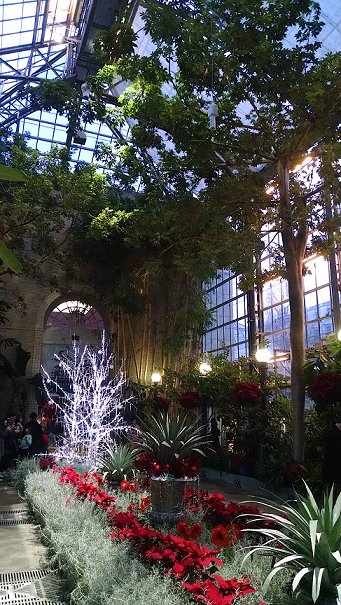
And thanks to everyone there for being so friendly and helpful.
Event Information
Swingology at Lake Accotink Park on 09/29/19
Event Information
Swingology at Evolution Home Outdoor Market on 09/14/19
Event Information
Swingology at Downtown Silver Spring Plaza on 11/16/19
Event Information
Swingology at Downtown Silver Spring Plaza on 10/19/19
Event Information
Swingology at Downtown Silver Spring Plaza on 09/21/19
Swingology at Mt Vernon Farmers Market on 09/07/19
Event Information
Swingology at Mt Vernon Farmers Market on 08/10/19
Event Information
Swingology at Falls Church Farmer’s Market on 06/29/19
Swingology at Ronald Reagan Building Woodrow Wilson Plaza on 09/10/19
Event Information
Swingology at Eastern Market on 06/22/19
Event Information
Swingology at Falls Church Farmer’s Market on 06/01/19
Event Information
Swingology at Falls Church Farmer’s Market on 06/29/19
Event Information
Swingology at North Springfield Elementary School on 03/27/19
Event Information
Swingology at Ashby Ponds Community Center on 9/12/19
Event Information
Swingology at Residences at Thomas Circle on 3/15/19
Event Information
Swingology at SongPo Radio on WERA 96.7 FM on 11/07/18
Event Information
Swingology at Haymarket Gainesville Community Library on 12/02/18
Event Information
Swingology at Private Party on 10/19/18
Event Information
Swingology at Falls Church Farmer’s Market on 06/23/18
Event Information
Swingology at Private Party on 07/28/18
Event Information
Swingology at Private Party on 06/15/18
Event Information
Swingology at Falls Church Distillery on 06/01/18
Event Information
Swingology at Falls Church Distillery on 04/07/18
Event Information
Swingology in Falls Church on 04/07/18
Event Information
Swingology in Northern Virginia on 05/18/18
Event Information
Swingology in Clifton on 05/13/18
Event Information
Swingology in Northern Virginia on 11/11/17
Event Information
Swingology in Falls Church on 08/26/17
Event Information
Swingology in Falls Church on 06/24/2017
Swingology! DC’s up and coming swing ensemble will hold it’s premiere Saturday, June 24, 9:00 a.m. at the Falls Church Farmer’s Market. Playing the best gypsy swing jazz, get ready for some toe tapping, be-bopping dance music as you wander through the market.
See more details here on Facebook
Pictures from the Farmer’s Market:
Event Information
Swingology at Prescott Studios on 06/03/2017
Swingology recently spent an afternoon at Prescott Studios recording some demos. For the session, the room was setup to capture live performance with no close miking or overdubs. The tracks are still in the editing suite, and we’re excited to share them. The band snapped a couple of pics from the live room between takes.
